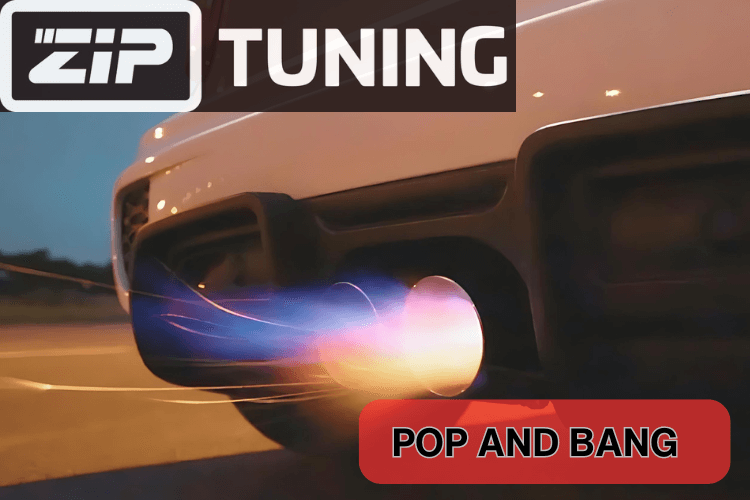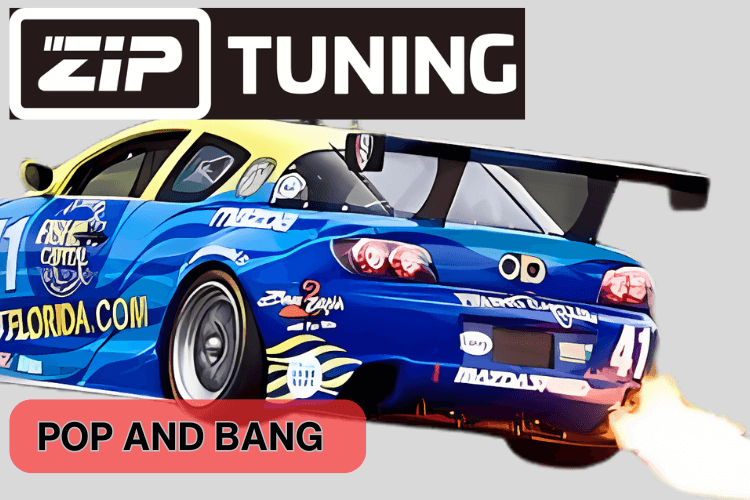Pop & Bang
Pop & Bang Tuning
Pop & Bang tuning, also known as crackle mapping or burble tuning, is a popular modification in the automotive enthusiast community. This technique involves precise ECU remapping to create a distinctive auditory experience characterized by pops, bangs, and crackles during throttle lift-off or gear shifts. The appeal lies in the enhanced exhaust note, adding an aggressive and sporty dimension to the driving experience.

Technical Breakdown of Pop & Bang Tuning
At its core, Pop & Bang tuning involves sophisticated manipulation of the Engine Control Unit (ECU) parameters. The process entails:
- ECU Remapping: Modifying the engine management software to alter fuel injection and ignition timing strategies.
- Fuel Injection Modification: Increasing fuel injection slightly during deceleration to ensure unburnt fuel enters the exhaust system.
- Ignition Timing Adjustment: Retarding ignition timing during overrun conditions, typically by 10-15 degrees and 30 degrees for very loud pops.
- Air-Fuel Ratio (AFR) Manipulation: Adjusting the AFR to be slightly rich (around 11.5:1 to 12.5:1) during specific conditions.
- Overrun Fuel Cut Disable: Disabling or modifying the fuel cut-off during deceleration.
ECU Maps and Parameters Modified
Key maps and parameters modified include:
- Fuel Injection Maps
- Ignition Timing Maps
- Throttle Position Sensor (TPS) to Fuel/Ignition Correlation
- Exhaust Gas Temperature (EGT) Limits
- Boost Control Maps (for turbocharged engines)
Vehicle Compatibility and Requirements
Pop & Bang tuning is compatible with most modern engines, including:
- Turbocharged gasoline engines (most responsive)
- Naturally aspirated gasoline engines
- Some diesel engines (with limitations)
Hardware considerations:
- Aftermarket exhaust systems enhance the effect
- Removal of catalytic converters may be necessary for maximum effect (where legally permitted)
Software prerequisites:
- OBD-II compliant vehicles
- ECUs with accessible flash memory
ZipTuning's Approach to Pop & Bang File Development
ZipTuning's methodology focuses on achieving the desired auditory effect while prioritizing engine safety:
- Customized Calibration: Tailoring each tune to the specific vehicle model.
- Safety Thresholds: Implementing strict limits on fuel enrichment and ignition retardation.
- Adaptive Strategies: Incorporating adaptive learning algorithms to adjust parameters based on driving conditions and component wear.

Advanced Features and Customization
ZipTuning offers various customization options:
- Activation Control: Integration with vehicle controls for on-demand activation.
- Aftermarket Exhaust Tuning: Tailored files for vehicles with aftermarket exhaust systems.
- Intensity Stages:
- Minor: Mild effect, suitable for stock exhaust systems
- Loud: Aggressive effect, optimized for aftermarket exhausts
Pop & Bang in Neutral / Park
ZipTuning's tuning files can be configured to work when the vehicle is stationary:
- Neutral Activation: Allowing Pop & Bang effects when the transmission is in neutral, even at idle.
- Rev-Based Triggering: Activating the effect at specific RPM ranges when revving in neutral or park.
- Temperature Safeguards: Implementing coolant temperature thresholds for activation.
- Duration Control: Limiting the effect's duration in stationary conditions.
Differentiating Pop & Bang from Related Effects
-
Pop & Bang vs. Shift Boom (DSG Farts):
- Pop & Bang: Controlled by ECU tuning, occurs on throttle lift-off and deceleration.
- Shift Boom: Characteristic of dual-clutch transmissions, caused by rapid air pressure changes during shifts.
-
Pop & Bang vs. Hardcut Limiter:
- Pop & Bang: Sustained effect during deceleration.
- Hardcut Limiter: Abrupt cut of fuel/ignition at redline, resulting in loud bangs and potential flames.
-
Pop & Bang and Burbles:
- Burbles are a milder form of Pop & Bang.
- ZipTuning can adjust intensity and frequency for various sound profiles.
Start-Up Roar for BMW and VAG
ZipTuning offers specialized start-up roar files for BMW and Volkswagen Audi Group (VAG) vehicles:
- Cold Start Enhancement: Modifying cold start fuel maps and ignition timing for a more aggressive initial engine note.
- BMW-Specific Tuning: Emulating M-series engine cold starts on non-M models.
- VAG Customization: Enhancing initial startup RPM and adjusting throttle position sensor mapping.
- Temperature-Based Activation: Ensuring the effect only occurs during true cold starts.
Safety and Reliability Considerations
ZipTuning prioritizes engine longevity through:
- Temperature Monitoring: Implementing strict EGT limits.
- Fuel Trim Safeguards: Maintaining appropriate long-term fuel trims.
- Catalyst Protection: Minimizing excessive temperatures for vehicles with catalytic converters.
- Load-Based Activation: Limiting the effect to low-load conditions.
ZipTuning's Pop & Bang Tuning Process
- Customer Registration: Create an account and purchase credits.
- ECU Read: Customers perform an ECU read using provided software.
- File Upload: Original ECU file is uploaded to ZipTuning's secure server.
- Expert Analysis: Engineers analyze the file and develop a custom tune.
- File Delivery: Modified file is uploaded for customer download.
- Installation and Testing: Customers flash the new file and test the vehicle.
- Support: Comprehensive support through a ticket system.

Average turnaround time is less than 15 minutes for standard files, but please be aware that due several factors and customer preferences pop&bang files need some rework. There is no one size fits all solution when it comes to pop&bang.
Latest Developments in Pop & Bang Tuning
Recent innovations include:
- Sport valve control: Adjusting the sport valve based on driving mode.
- OPF-Friendly: Developing files compatible with Otto Particulate Filters in newer vehicles.
ZipTuning continually invests in research and development to stay at the forefront of tuning technology, ensuring customers receive cutting-edge, safe, and effective Pop & Bang files.
Need pop and bang tuning files?
Pop & Bang Tuning FAQs
What is Pop & Bang tuning and how does it work?
Pop & Bang tuning modifies ECU parameters to create a distinctive exhaust sound during deceleration. Key modifications include adjusting fuel injection maps, creating specific overrun ignition maps, modifying TPS to fuel/ignition correlation, implementing EGT limits, and adjusting boost control maps for turbocharged engines.
How does Pop & Bang tuning affect long-term engine reliability?
While ZipTuning prioritizes engine longevity through strict EGT limits, appropriate long-term fuel trims, and catalyst protection strategies, Pop & Bang tuning will always have some negative impact on engine longevity. We limit the effect to low-load conditions to minimize issues during high-performance driving.
What safety measures are in place to prevent engine damage?
We implement temperature monitoring, fuel trim safeguards, catalyst protection, and load-based activation. These measures limit the effect to low-load conditions and prevent excessive exhaust gas temperatures.
How do you balance the auditory effect with catalytic converter protection?
For vehicles with catalytic converters, we employ strategies to minimize excessive temperatures, including strict limits on fuel enrichment and ignition retardation. However, Pop & Bang tuning will always affect catalyst longevity to some degree.
Can Pop & Bang tuning be implemented on vehicles with Otto Particulate Filters (OPF)?
Yes, we’re developing OPF-friendly files, but Pop & Bang will negatively affect OPF longevity. While many customers retain their OPFs, we recommend removal for optimal results.
What are the differences in tuning approach for turbocharged vs. naturally aspirated engines?
Both engine types can be tuned for Pop & Bang, but turbocharged engines are generally more responsive. For turbocharged engines, we adjust boost control maps on some ECU types to maintain turbo speed during deceleration.
Can Pop & Bang tuning be customized for different driving modes?
Yes, we offer activation control that can be integrated with vehicle controls (e.g., sport button) for on-demand activation on some ECU types and gearboxes.
How does Pop & Bang tuning affect fuel economy and emissions during normal driving?
By maintaining appropriate long-term fuel trims, we minimize the impact on normal driving conditions.
Can Pop & Bang tuning be safely implemented on high-mileage engines?
While not specifically addressed, our safety and reliability considerations suggest it could be implemented with proper precautions on high-mileage engines.
What are the limitations of Pop & Bang tuning on diesel engines?
We don’t offer Pop & Bang tuning for diesel engines as it typically limits car performance. Some solutions exist to mimic the sound, but we don’t recommend these for our customers.
Can Pop & Bang tuning be integrated with a downpipe?
Yes, but a downpipe can slightly silence the pops, so we may need to make them stronger. Many customers with stock pops seek our services after installing a downpipe because they’ve lost the original effect.
How does Pop & Bang tuning work with aftermarket exhaust systems?
Pop & Bang tuning can be integrated with aftermarket exhaust systems, but it may require more fine-tuning to achieve the desired effect.
What diagnostic data do you monitor to fine-tune the Pop & Bang effect?
Depending on the ECU type, monitoring Exhaust Gas Temperature (EGT) and fuel trims can be helpful in fine-tuning the Pop & Bang effect.

